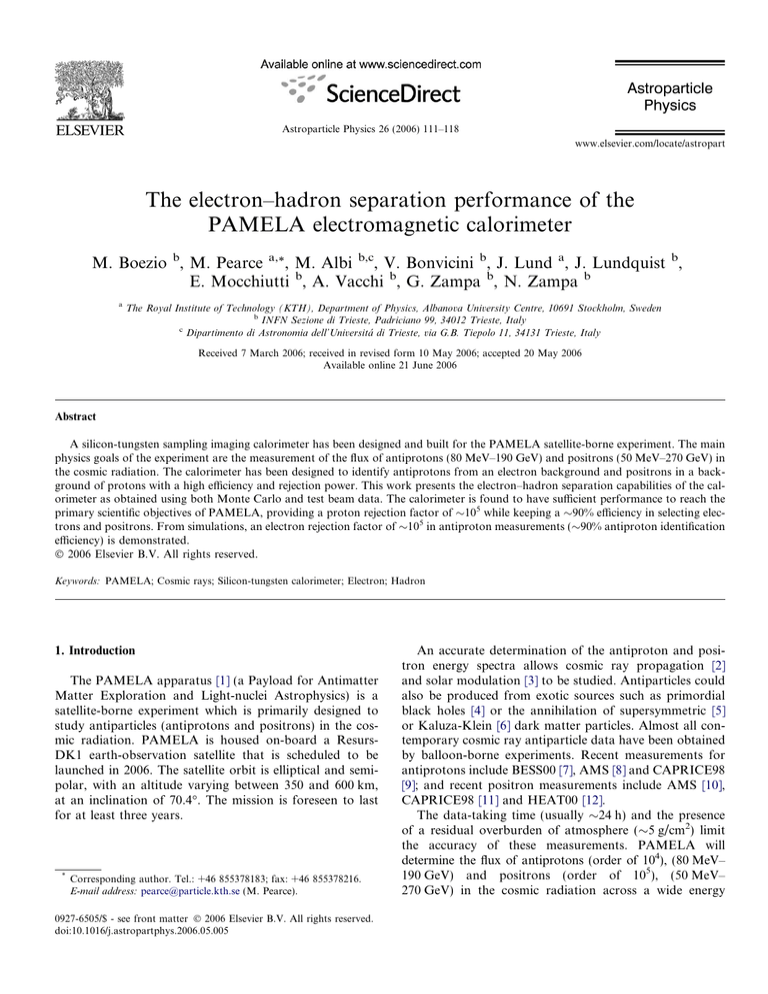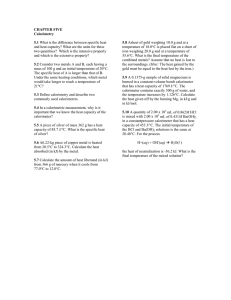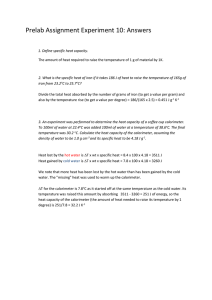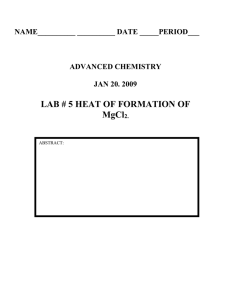
Astroparticle Physics 26 (2006) 111–118
www.elsevier.com/locate/astropart
The electron–hadron separation performance of the
PAMELA electromagnetic calorimeter
M. Boezio b, M. Pearce a,*, M. Albi b,c, V. Bonvicini b, J. Lund a, J. Lundquist b,
E. Mocchiutti b, A. Vacchi b, G. Zampa b, N. Zampa b
a
The Royal Institute of Technology (KTH), Department of Physics, Albanova University Centre, 10691 Stockholm, Sweden
b
INFN Sezione di Trieste, Padriciano 99, 34012 Trieste, Italy
c
Dipartimento di Astronomia dell’Universitá di Trieste, via G.B. Tiepolo 11, 34131 Trieste, Italy
Received 7 March 2006; received in revised form 10 May 2006; accepted 20 May 2006
Available online 21 June 2006
Abstract
A silicon-tungsten sampling imaging calorimeter has been designed and built for the PAMELA satellite-borne experiment. The main
physics goals of the experiment are the measurement of the flux of antiprotons (80 MeV–190 GeV) and positrons (50 MeV–270 GeV) in
the cosmic radiation. The calorimeter has been designed to identify antiprotons from an electron background and positrons in a background of protons with a high efficiency and rejection power. This work presents the electron–hadron separation capabilities of the calorimeter as obtained using both Monte Carlo and test beam data. The calorimeter is found to have sufficient performance to reach the
primary scientific objectives of PAMELA, providing a proton rejection factor of 105 while keeping a 90% efficiency in selecting electrons and positrons. From simulations, an electron rejection factor of 105 in antiproton measurements (90% antiproton identification
efficiency) is demonstrated.
2006 Elsevier B.V. All rights reserved.
Keywords: PAMELA; Cosmic rays; Silicon-tungsten calorimeter; Electron; Hadron
1. Introduction
The PAMELA apparatus [1] (a Payload for Antimatter
Matter Exploration and Light-nuclei Astrophysics) is a
satellite-borne experiment which is primarily designed to
study antiparticles (antiprotons and positrons) in the cosmic radiation. PAMELA is housed on-board a ResursDK1 earth-observation satellite that is scheduled to be
launched in 2006. The satellite orbit is elliptical and semipolar, with an altitude varying between 350 and 600 km,
at an inclination of 70.4. The mission is foreseen to last
for at least three years.
*
Corresponding author. Tel.: +46 855378183; fax: +46 855378216.
E-mail address: pearce@particle.kth.se (M. Pearce).
0927-6505/$ - see front matter 2006 Elsevier B.V. All rights reserved.
doi:10.1016/j.astropartphys.2006.05.005
An accurate determination of the antiproton and positron energy spectra allows cosmic ray propagation [2]
and solar modulation [3] to be studied. Antiparticles could
also be produced from exotic sources such as primordial
black holes [4] or the annihilation of supersymmetric [5]
or Kaluza-Klein [6] dark matter particles. Almost all contemporary cosmic ray antiparticle data have been obtained
by balloon-borne experiments. Recent measurements for
antiprotons include BESS00 [7], AMS [8] and CAPRICE98
[9]; and recent positron measurements include AMS [10],
CAPRICE98 [11] and HEAT00 [12].
The data-taking time (usually 24 h) and the presence
of a residual overburden of atmosphere (5 g/cm2) limit
the accuracy of these measurements. PAMELA will
determine the flux of antiprotons (order of 104), (80 MeV–
190 GeV) and positrons (order of 105), (50 MeV–
270 GeV) in the cosmic radiation across a wide energy
112
M. Boezio et al. / Astroparticle Physics 26 (2006) 111–118
range and with unprecedented statistics. The measurements
are complicated by the substantial background from protons (for the positron flux) and electrons (in the case of
antiprotons). The ability of the PAMELA electromagnetic
calorimeter to separate electrons1 from hadrons has been
studied using particle beam tests and Monte Carlo simulations. The results are presented in this paper.
In the next section, the PAMELA experiment is
described with particular attention paid to the electromagnetic calorimeter. In Section 3, the electron–hadron separation method is described. In Section 4 the simulations and
tests at particle beams used to assess the electron–hadron
separation performance are described. The results from
these studies are presented in Section 5 and are discussed
in the context of the in-orbit performance of the calorimeter in Section 6. Finally, conclusions are presented in Section 7.
2. The PAMELA experiment
The layout of the PAMELA experiment is detailed in
Fig. 1. PAMELA is built around a 0.43 T permanent magnet spectrometer (‘tracker’) equipped with six planes of
300 lm thick double-sided silicon detectors allowing the
sign, absolute value of charge and momentum of traversing
charged particles to be determined [13]. The acceptance of
the tracker (which also defines the overall acceptance of the
PAMELA experiment) is 21.5 cm2sr and the maximum
detectable rigidity is 1 TV. The limited tracking resolution causes a fraction of high momentum particles, i.e. with
low deflection, to be reconstructed with the wrong curvature. Thus, they are assigned the wrong sign of the charge
(spillover effect). Since there are many more protons than
antiprotons and relatively more electrons than positrons,
spillover effects limit the upper detectable antiparticle
momentum to 190 GeV/c (270 GeV/c) for antiprotons
(positrons). The tracker is surrounded by a plastic scintillator veto shield [14]. An electromagnetic calorimeter
mounted below the tracker measures the energy of incident
electrons and allows topological discrimination between
electromagnetic and hadronic showers (or non-interacting
particles). This discriminatory ability is the focus of this
paper. The calorimeter is described more fully in Section
2.1. Planes of plastic scintillator mounted above and below
the tracker form a time-of-flight system which also provides the primary experimental trigger [15]. The timing resolution of the time-of-flight system is 300 ps which allows
albedo particles to be rejected at the 60 sigma level. Protonelectron separation is also possible below 1 GeV/c. Ionising energy loss measurements allow an estimation of the
absolute charge of particles selected by the time-of-flight
system as down-going. The volume between the upper
two time-of-flight planes is bounded by an additional plas-
1
The term electron also refers to positrons, unless specifically stated
otherwise.
Fig. 1. A schematic overview of the PAMELA satellite experiment. The
experiment stands 1.2 m high and, from top to bottom, consists of a
time-of-flight (ToF) system (S1, S2, S3 scintillator planes), an anticoincidence shield system, a permanent magnet spectrometer (the magnetic
field runs in the y-direction), a silicon-tungsten electromagnetic calorimeter, a shower tail scintillator (S4) and a neutron detector. The experiment
has an overall mass of 450 kg. The origin of the PAMELA coordinate
system is located at the centre of the tracking system. The x-axis runs to
the right, parallel to the silicon planes in the spectrometer, the y-axis
points into the page, and the z-axis is orientated vertically.
tic scintillator anticoincidence system. A plastic scintillator
system mounted beneath the calorimeter provides an additional stand-alone trigger for high energy electrons and is
followed by a neutron detection system comprising 3Hefilled tubes within a polyethylene moderator for the selection of very high energy electrons and positrons (up to
3 TeV) which shower in the calorimeter but do not necessarily pass through the spectrometer.
2.1. The electromagnetic calorimeter
The sampling electromagnetic calorimeter comprises 44
single-sided silicon sensor planes (380 lm thick) interleaved
with 22 plates of tungsten absorber [16]. Each tungsten
layer has a thickness of 0.26 cm, which corresponds to
0.74 X0 (radiation lengths), giving a total depth of 16.3
X0 (0.6 nuclear interaction lengths). Each tungsten plate
is sandwiched between two printed circuit boards upon
which the silicon detectors and associated read-out electronics are mounted. The 8 · 8 cm2 silicon detectors are
segmented into 32 read-out strips with a pitch of 2.4 mm.
The silicon detectors are arranged in a 3 · 3 matrix and
each of the 32 strips is bonded to the corresponding strip
M. Boezio et al. / Astroparticle Physics 26 (2006) 111–118
Fig. 2. The PAMELA electromagnetic calorimeter partially equipped
with silicon and tungsten planes. The device is 20 cm tall and the active
silicon layer is 24 · 24 cm2 in cross-section. Some of the circuit boards
upon which the silicon detectors are mounted are partially extracted.
on the other two detectors in the same row (or column),
thereby forming 24 cm long read-out strips. The orientation of the strips of two consecutive layers is orthogonal
and therefore provides two-dimensional spatial information (‘views’). Fig. 2 shows the calorimeter prior to integration with the other PAMELA detectors. As well as
providing a means to distinguish between electrons and
hadrons, the calorimeter reconstructs the energy of incident
electrons independently from the tracking system, allowing
a cross-calibration between the two methods. The constant
term for the calorimeter energy resolution has been measured as 5.5% for electromagnetic showers generated by
particles entering the calorimeter within the acceptance of
the tracking system up to an energy of several hundred
GeV.
3. Electron–hadron separation
Protons and electrons dominate the positively and negatively charged components of the cosmic radiation,
respectively. One of the main tasks of the calorimeter is
to select positrons and antiprotons from like-charged backgrounds which are significantly more abundant. Positrons
must be identified from a background of protons that
increases from about 103 times the positron component
at 1 GeV/c to 5 · 103 at 10 GeV/c and antiprotons from
a background of electrons that decreases from 5 · 103
times the antiproton component at 1 GeV/c to less than
102 times above 10 GeV/c. This means that the PAMELA
system must separate electrons from hadrons at a level of
105–106. Much of this separation must be provided by
the calorimeter, i.e. electrons must be selected with an
acceptable efficiency and with as small a hadron contamination as possible.
The main stages for the identification of electrons and
antiprotons are as follows. The time-of-flight system is used
to select down-going singly-charged particles (proton-electron separation is possible below 1 GeV/c). Information
from the tracker is then used to determine the sign of
charge and rigidity (momentum/charge) over a wide range
of momenta (50 MeV/c to 1 TeV/c). Finally, the longi-
113
tudinal and transverse segmentation of the calorimeter,
combined with the measurement of the particle energy loss
in each silicon strip, allows a high identification (or rejection) power for electromagnetic showers. Electromagnetic
and hadronic showers differ in their spatial development
and energy distribution in a way that can be distinguished
by the calorimeter. This is demonstrated in Fig. 3 which
shows examples of an electromagnetic shower induced by
an electron (left) and an interacting proton (right),
recorded during tests with particle beams at the CERN
SpS facility. All incident particles have a momentum of
50 GeV/c.
The use of a simple variable, such as the total energy
deposited in the calorimeter, allows an effective separation
between electrons and hadrons. For incident hadrons of a
given energy, the distribution of total energy deposited in
the calorimeter is essentially flat with a sharp peak at low
energies for non-interacting hadrons. For electrons, the
total energy deposited in the calorimeter for a given incident
energy is normally distributed, as long as most of the shower
is contained. For higher electron energies, a tail to low energies can, however, decrease the efficiency for electron identification. The use of this variable is illustrated in Fig. 4
where the total energy deposited by 67504 protons and
3342 electrons at 50 GeV/c of momentum are shown. After
a cut placed at 7300 mip (where 1 mip is the energy deposited by a minimum ionising particle) 14 protons (99.98%
reduction) and 3197 electrons (4.3% reduction) remain.
Additional variables have been used to further separate
electromagnetic and hadronic showers in the calorimeter.
Several of these variables rely on the derivation of the
shower axis. Where possible the shower axis is defined
using tracking information from the tracking system.
When this is not possible because (e.g.) the tracker was
not present during the beam tests, the following procedure
is adopted. The 22 silicon planes in each view are divided
into strips. The impact point within the ith plane is defined
as the centre of gravity, x, of the measured energies, Ei
(>0.7Pmip) deposited in strips with co-ordinates xi, where
xi E i
x ¼ Pi . When this procedure is performed at several
i
Ei
depths in the calorimeter, the shower axis can be determined by a linear fitting procedure to an accuracy of a
few mm. In flight, the shower axis will be determined using
tracking information from the spectrometer with an
expected 103 improvement in accuracy. In the following
sections each of the additional variables used to distinguish
between electron and hadron interactions are described in
detail.
3.1. The starting point of the shower
There is a high probability (>89%) that an electromagnetic shower will start in the first 3 planes of the calorimeter.
For hadronic showers, the starting
point is distributed more
P2 P
22
uniformly. The variable R ¼ j¼1 i¼1 hij i, is formed as a
sum over the 22 calorimeter planes which each contain 2
114
M. Boezio et al. / Astroparticle Physics 26 (2006) 111–118
Y view
X view
Y view
44.5 cm
44.5 cm
X view
MIP
1000.
MIP
1000.
MIP
1000.
MIP
1000.
100.
100.
100.
100.
10.
10.
10.
10.
1.
1.
1.
1.
0.
0.
0.
0.
Date 030921 File 323 Event 48
Date 030921 File 293 Event 19
Fig. 3. An event display of a 50 GeV/c electron (left) and proton (right) recorded at CERN SpS facility. In the top part of the figure both views (X-left, Yright) of the six silicon planes are shown inside the magnetic cavity (field lines in the Y-direction). Hits in the tracking system are shown (including
ambiguities for the Y-view). In the bottom part of the figure, the two views (X and Y) of the calorimeter are shown. The colour scale indicates the detected
energy in each strip (from dark (blue in webversion) none, to light (orange in webversion), greater than 100 mip). The topological and energetic differences
between electromagnetic and hadronic showers can be clearly seen. Signals from the odd planes of the Y-view of the calorimeter were not read out during
this test. One of the X-view planes was also not operational and was later replaced.
values. Another variable which is sensitive to the starting
point of the shower is the energy deposited in a cylinder
of diameter four times the Molière radius (Rm) for tungsten
(8 silicon strips) evaluated for the first 3 calorimeter planes.
3.2. The longitudinal shower profile
Fig. 4. An illustration of electron–proton separation using a simple total
deposited energy variable. The test beam data were collected for particles
of momentum 50 GeV/c. After a cut placed at 7300 mip 14 protons
(99.98% reduction) and 3197 electrons (4.3% reduction) remain.
orthogonal views and hij = 1 if the ith plane of the jth view
has strips registering energies compatible with a minimum
ionising particle within 4 mm from the reconstructed
shower axis. If this condition is not fulfilled then hij = 0.
For electromagnetic showers, R assumes low values, while
for a non- or partially-interacting hadron, R takes higher
The energy deposited in an electromagnetic shower significantly decreases and spatially broadens after the shower
maximum. The location of the maximum is derived using
the momentum of the particle derived by the tracking system or by the beam set-up. For a hadronic shower, energy
is deposited approximately uniformly and any maximum
lies deeper in the calorimeter for a given incident energy.
The longitudinal shower profile is assessed by determining
what fraction of the total deposited energy lies at least five
planes after the expected electromagnetic shower maximum. Another variable sensitive to the longitudinal shower
profile is the amount of energy deposited in the last four
calorimeter planes within a cylinder of radius 2Rm. This
variable assumes a lower value for electromagnetic showers
where the shower maximum is usually contained within the
calorimeter. The maximum energy detected in a single strip
can also be used. For hadronic events this can be very large
if (e.g.) a silicon nucleus is fragmented.
3.3. The transverse shower profile
The transverse shower profile is evaluated through the
amount of energy deposited per strip inside a cylinder of
M. Boezio et al. / Astroparticle Physics 26 (2006) 111–118
radius 2Rm centred on the reconstructed shower axis. For
electrons, 95% of the deposited energy should fall within
the cylinder. This is a potentially powerful way to separate
electrons and hadrons but requires a reliable definition of
the shower axis. This selection is therefore likely to be more
performant in flight when the tracker can be used to define
the shower axis.
3.4. The topological development of the shower
For electromagnetic showers, the shower particle multiplicity is expected to increase with calorimeter depth up to
the shower maximum. Furthermore, the shower particles
should be collimated along the shower axis.
variable
P2AP
plmax
exploiting this behaviour is defined as
j¼1
i¼1 nhit
ði; jÞ i, where nhit is the number of hit strips in the jth view
of plane i within a cylinder of radius 2Rm centred on the
shower axis. The sum over planes is truncated at the calculated electromagnetic shower maximum for a given incident energy, plmax, for a given incident energy provided
by either the tracking system or by the beam set-up. For
electromagnetic (hadronic) showers this variable assumes
high (low) values.
4. Particle beam tests and simulations
The electron–hadron separation of the calorimeter has
been evaluated using data from tests with particle beams
at CERN and Monte Carlo simulations. There are two
aims to this study. The first is to estimate the calorimeter’s
hadron rejection capability and electron selection efficiency. The second is a comparison between test beam
Fig. 5. The total energy deposited in the calorimeter, recorded for
electrons of momentum 200 GeV/c. Data are shown as a solid line while
simulations are shown as a dashed line.
115
and simulation results which can be used to validate simulation studies of the calorimeter in situations resembling
those expected in orbit, as discussed in Section 6.
The test beam data used in the analyses were collected at
three different occasions at the CERN PS and SPS test
beam facilities during 2002 and 2003. In each test, the calorimeter was equipped with approximately half of the total
number of silicon planes. The performance results presented in the next section are therefore conservative. Monte
Carlo simulations of the calorimeter performance used the
GEANT framework, version 3.21 [17]. The default GHEISHA hadron shower package was used to simulate the
interactions of hadrons with the nuclei of the matter traversed. The incident particle beams were assumed to be
monoenergetic and contamination free. The validity of
these assumptions is further discussed in [18]. The simulation was found to reproduce the data well. This is demonstrated in Fig. 5 which shows the total energy deposited in
the calorimeter for electrons of momentum 200 GeV/c for
both test beam data and simulations.
5. Results
Combinations of the variables described in Section 3
were used to provide electron–hadron separation at a given
incident particle energy. The selections were optimised
using only the data collected during particle beam tests.
Monte Carlo simulations were not used for this purpose.
The complete set of selections used for each incident
particle energy is listed elsewhere [18]. As an example, a
selection based on the topological variable described in
Section 3.4 is applied to the 3197 electrons and 14 protons
remaining after the simple total energy cut described in
Fig. 4. After this selection is performed, 3116 electrons
(2.5% reduction) and 7 protons (50% reduction) remain,
as shown in Fig. 6.
Fig. 7 shows the efficiency (upper panel) and contamination (lower panel) of the final electron selection as a function of momentum. The full circles represent test beam
data and the open squares represent simulated data. When
tuning the data selections, the electron efficiency was kept
above 90% where-ever possible. The agreement between
simulation and experimental data is acceptable. In the
lower panel of Fig. 7 the proton contamination is shown
as a function of momentum for both beam test data (full
circles) and simulated data (open squares). The arrows
show the 68% confidence levels if no events survived the
selection. The data points at 3 and 10 GeV/c are for electron/pion separation and therefore do not directly apply
to the electron/proton separation study because pions with
a momentum of 3 GeV/c have 1 GeV more kinetic energy
that can be deposited in the calorimeter, than protons of
the same momentum. This will result in a higher contamination for pions compared to protons. However, the pion
data can usefully be used to compare simulation and beam
test results. Good agreement between simulations and
beam test data can be seen. Fluctuations in the measured
116
M. Boezio et al. / Astroparticle Physics 26 (2006) 111–118
and read out [18]), energy dependent selections and different beam conditions (direction and impact point on the
calorimeter). These results refer to a partially equipped
calorimeter and should be considered as lower limits of
the calorimeter performance.
6. Discussion
Fig. 6. The upper panel shows the topological variable (‘number of
hits · plane number’) described in Section 3.4 for the same 67504 protons
and 3342 electrons as shown in Fig. 4. In the lower panel, the events
remaining after a total energy cut at 7300 mip are shown, corresponding to
3197 electrons and 14 protons. A further cut on the topological variable at
1500 leaves 3116 electrons (2.5% reduction) and 7 protons (50% reduction).
Fig. 7. Upper panel: The electron identification efficiency, shown as a
function of incident particle momentum. The full circles and open squares
represent beam test and simulated data, respectively. Lower panel: The
proton contamination in the electron selection, shown as a function of
incident particle momentum. The full circles and open squares represent
beam test and simulated data, respectively. The arrows indicate the 68%
confidence level for test beam data if no events survive the selection. The
dashed arrow is for simulated protons at 200 GeV/c. The data at 10, 40
and 200 GeV/c are displaced for clarity.
In this section the scientific results achievable with the
PAMELA experiment employing its calorimeter as a positron and antiproton identifier are discussed. As shown in
the previous section, results obtained from test beam data
indicate that even with a partially equipped calorimeter it
is possible to achieve a proton rejection factor of at least
105 above 10 GeV/c while maintaining an electron selection efficiency of 90%. Furthermore, a good agreement
is found between simulated and experimental calorimeter
data. Therefore, simulation tools have been used to study
the in-orbit performance of the calorimeter. The simulation
employed the GPAMELA code [19] that reproduces the
entire PAMELA geometry and component detectors.
Proton, positron, electron and antiproton energy spectra
were simulated using published particle fluxes [5,20,21]
assuming pure secondary production during cosmic-ray
propagation in the galaxy for positrons and antiprotons.
The fluxes were simulated for momenta above 1 GeV/c
since at lower momenta a clean separation between protons/positrons and antiprotons/electrons is provided by
the velocity and ionization losses measured by the ToF system, as verified using ground data cosmic rays. An isotropic distribution of down-going particles were simulated
above PAMELA and events were saved for further study
if a ‘trigger’ was generated, i.e. coincidental signals in the
three layers of ToF scintillators. Only singly-charged particles identified by the ToF scintillators were used for the calorimeter studies. The particle direction and momentum
derived by the tracking system was also used with the calorimeter information. The momentum information was
smeared according to the experimental momentum resolution (0.001 GV1). Positrons were identified with the calorimeter as described in the previous sections and
antiprotons were identified by selecting electromagnetic
showers in the calorimeter with the highest possible efficiency and then rejecting them.
Fig. 8 shows the results of these analyses for positrons.
The filled circles indicate the expected PAMELA performance for a pure secondary positron component (solid
line, from [21]). Statistical errors accounting for the calorimeter selection efficiency and a three year long mission
are included in the expected PAMELA data. The data
are multiplied by p2.7 (where p is momentum) for clarity.2
As well as the expected positron spectrum, the figure also
shows the proton component. The dotted line indicates
2
efficiencies as a function of energy are due to different
calorimeter configurations (i.e. number of planes equipped
The fluxes are presented in momentum units since the selection
conditions are momentum based, with the momentum (rigidity) determined by the tracking system.
M. Boezio et al. / Astroparticle Physics 26 (2006) 111–118
Fig. 8. The PAMELA calorimeter in-orbit identification performance for
positrons. The solid line represents the cosmic-ray positron spectrum for
a pure secondary origin [21]; the dotted line represents the cosmic-ray
proton spectrum (from [20]); the dashed line represents the spectrum of
protons surviving the calorimeter positron selection. The expected
PAMELA performance for a pure secondary component (filled circles)
is also indicated together with statistical errors.
the cosmic-ray proton spectrum (from [20]) clearly showing
the background level for the positron analysis. The dashed
line shows the spectrum of protons which survives the calorimeter positron selection. The surviving protons account
for 9% of the positron flux at 1 GeV/c, decreasing to
below 5% above 1.5 GeV/c and flattening out to below
2% above 3 GeV/c.
Similarly, Fig. 9 shows the expected PAMELA performance for a pure secondary antiproton component (solid
line, from [5]) along with the electron spectrum before (dotted line, from [21]) and after (dashed line) the calorimeter
antiproton selection. After selection electrons account for
less than 2% of the antiproton flux at 1 GeV/c and this
decreases to below 1% above 1.5 GeV/c.
It should be noted that below 2 GeV/c additional proton/electron rejection power is provided by the ToF system
and above 10 GeV/c by the neutron detector.
7. Conclusions
The PAMELA calorimeter has been extensively tested at
particle beam facilities and studied with simulations. Combining these data, the electron/hadron separation performance of the calorimeter has been determined. It has
been shown that the PAMELA calorimeter is able to identify the rare antiproton and positron components in the
cosmic radiation with a background at the percent level
and lower, especially at scientifically interesting momenta
>10 GeV/c.
117
Fig. 9. The PAMELA calorimeter in-orbit identification performance for
antiprotons. The solid line represents the cosmic-ray antiproton spectrum
for a pure secondary origin [5]; the dotted line represents the cosmic-ray
electron spectrum (from [21]); the dashed line represents the spectrum of
electrons surviving the calorimeter antiproton selection. The expected
PAMELA performance for a pure secondary component (filled circles) is
indicated. Only statistical errors are included for the expected PAMELA
data.
Acknowledgements
The authors thank the PAMELA Collaboration for
their support during the writing of this paper. In particular,
we would like to acknowledge Francesco Cafagna and
Marialuigia Ambriola for their help with the PAMELA
simulation package, GPAMELA; Francesca Volpe for
her help in setting up simulation codes; and Elena Vannuccini for her help with the tracker data. The KTH group
thanks The Swedish National Space Board (Rymdstyrelsen) and The Swedish Research Council (Vetenskapsrådet)
for financial support.
References
[1] M. Boezio, The PAMELA space experiment, in: Proceedings of the
29th International Cosmic Ray Conference, Pune, India, 2005.
Available from: <http://wizard.roma2.infn.it/pamela>.
[2] See for example: I.V. Moskalenko et al., ApJ. 586 (2003) 1050.
[3] See for example: Y. Asaoka et al., Phys. Rev. Lett. 88 (2002)
051101.
[4] K. Maki et al., Phys. Rev. Lett. 76 (1996) 3474.
[5] L. Bergström et al., Phys. Rev. D. 59 (1999) 43506.
[6] D. Hooper et al., Phys. Rev. D. 71 (2005) 083503.
[7] Y. Asaoka et al., Phys. Rev. Lett. 88 (2002) 051101. Available from:
<astro-ph/0109007>.
[8] M. Aguilar et al., Phys. Rept. 366 (2002) 331.
[9] M. Boezio et al., Astrophys. J. 561 (2001) 787. Available from:
<astro-ph/0103513>.
[10] J. Alcaraz et al., Phys. Lett. B 484 (2000) 10.
[11] M. Boezio et al., Adv. Space Res. 27 (2001) 669.
118
M. Boezio et al. / Astroparticle Physics 26 (2006) 111–118
[12] J.J. Beatty et al., Phys. Rev. Lett. 93 (2004) 241102, astro-ph/
0412230.
[13] A. Adriani et al., Nucl. Instr. and Meth. A 511 (2003) 72.
[14] S. Orsi et al., Adv. Space Res. 37 (10) (2006) 1853–1856.
[15] G. Osteria et al., Nucl. Instr. and Meth. A 535 (2004) 152.
[16] M. Boezio et al., Nucl. Instr. and Meth. A 487 (2002) 407.
[17] R. Brun et al., Detector description and simulation tool, CERN
Program Library (1994).
[18] J. Lund, Antiparticle identification studies for the PAMELA satellite
experiment’, PhD thesis, KTH, Stockholm, 2004. Available from:
<http://www.particle.kth.se>.
[19] GPAMELA simulation code homepage: http://www.ba.infn.it/
~ambriola/gpamela/.
[20] T.K. Gaisser et al., in: Proceedings of the 27th International Cosmic
Ray Conference, Hamburg, Germany, vol. 5, p. 1643, 2001.
[21] I.V. Moskalenko, A.W. Strong, Astrophys. J. 493 (1998) 694.






